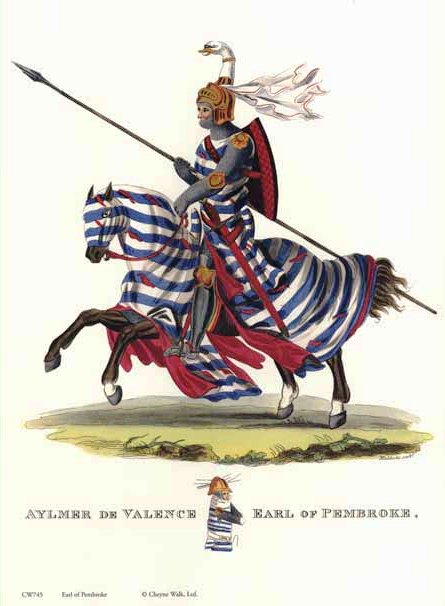Aymer de Valence: 2nd Earl of Pembroke
William de Valence died in 1296, and Aymer inherited his father's French lands, but had to wait until his mother died in 1307 to succeed to the earldom. In 1320, his first wife Béatrice de Clermont died. In 1321, Aymer married his second wife Marie de St Pol. Through inheritance and marriages his lands consisted of—apart from the county palatine in Pembrokeshire—property spread out across England primarily in a strip from Gloucestershire to East Anglia, in south-east Ireland (Wexford), and French lands in the Poitou and Calais areas. In 1297 he accompanied Edward I on a campaign to Flanders, and seems to have been knighted by this time. With his French connections he was in the following years a valuable diplomat in France for the English King.
He also served as a military commander in Scotland, fighting against Robert the Bruce. In 1306 at the Battle of Methven he won the day over Bruce in a sneak attack, only to be soundly defeated by Bruce at Loudoun Hill the next year. Edward I died in 1307 and was succeeded by his son Edward II. The new king at first enjoyed the goodwill of his nobility, Valence among them. Conflict soon ensued, however, connected especially with the enormous unpopularity of Edward's favourite Piers Gaveston. Gaveston's arrogance towards the peers, and his control over Edward, united the Baronage in opposition to the king. In 1311 the initiative known as the Ordinances was introduced, severely limiting Royal powers in financial matters and in the appointment of officers. Equally important, Gaveston was expelled from the realm, as Edward I had already done once before. Pembroke, who was not among the most radical of the Ordainers, and had earlier been sympathetic with the king, had now realised the necessity of exiling Gaveston.
When Gaveston without permission returned from exile later the same year, a Baronial council entrusted Pembroke and the Earl of Surrey, with the task of taking him into custody. This they did on 19 May 1312, but not long after Thomas of Lancaster, acting with the earls of Warwick, Hereford and Arundel, seized Gaveston and executed him on 19 June. This act had the effect of garnering support for the king and marginalising the rebellious earls. As far as Pembroke was concerned, the seizing and execution of a prisoner in his custody was a breach of the most fundamental chivalric codes, and a serious affront to his honour. The event must therefore be seen as pivotal in turning his sympathies away from the rebels and towards the king. In the following years, Pembroke worked closely with the king. He was appointed the king's lieutenant in Scotland in 1314, and was present at the disastrous English defeat at the Battle of Bannockburn, where he helped lead Edward away from the field of battle. In 1317, however, while returning from a papal embassy to Avignon, he was captured by a Jean de Lamouilly, and held for ransom in Germany. The ransom of £10,400 was to cause Pembroke significant financial difficulties for the remainder of his life.
Although ostracised because of the murder of Gaveston, Thomas of Lancaster had regained virtual control of royal government in the period after England's defeat at Bannockburn. Proving himself as incapable to rule as Edward, however, he soon grew unpopular. Pembroke was one of the magnates who in the years 1316–1318 tried to prevent civil war from breaking out between the supporters of Edward and those of Lancaster, and he helped negotiate the Treaty of Leake in Nottinghamshire in 1318, restoring Edward to power. Peace did not last long, however, as the king by now had taken on Hugh Despenser the Younger as another favourite, in much the same position as Gaveston. Pembroke's attempts at reconciliation eventually failed, and civil war broke out in 1321. In 1322 Lancaster was defeated at the Battle of Boroughbridge in what is now North Yorkshire, and executed. Pembroke was among the earls behind the conviction. Also in 1322, Pembroke founded a leper hospital in Gravesend.
After Boroughbridge, Pembroke found himself in a difficult situation. The opponents of Hugh Despenser and his father had lost all faith in him, but at the same time, he found himself marginalised at court where the Despensers' power grew more and more complete. On top of this came his financial problems. On 23 June 1324, while on an embassy to France, he suddenly collapsed and died while lodging somewhere in Picardy, he was buried alongside his father in splendor at Westminster Abbey. Aymer married twice; his first marriage, before 1295, was to Beatrice, daughter of Raoul de Clermont, Lord of Nesle in Picardy and Constable of France. Beatrice died in 1320, and in 1321 he married Marie de St Pol, daughter of Guy de Châtillon, Count of St Pol and Butler of France. He never had any legitimate children, but he had an illegitimate son, Henry de Valence, whose mother is unknown. Pembroke's most lasting legacy is probably through his second wife, who in 1347 founded Pembroke College, Cambridge. The family arms are still represented on the dexter side of the college arms. Aymer de Valence was buried in Westminster Abbey, where his tomb effigy can still be seen as a splendid example of late gothic architecture, elaborating on the design of the nearby tomb of Edmund Crouchback, Earl of Lancaster.
 |
| The magnificent tomb of Aymer de Valence in Westminster Abbey, engraved by Edward Blore |

Comments
Post a Comment